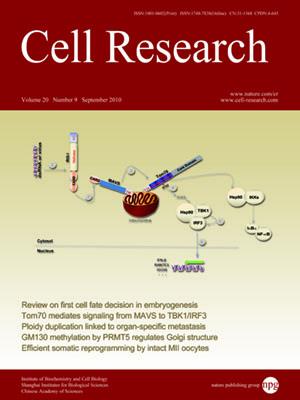
Volume 20, No 9, Sep 2010
ISSN: 1001-0602
EISSN: 1748-7838 2018
impact factor 17.848*
(Clarivate Analytics, 2019)
Volume 20 Issue 9, September 2010: 1023-1033
ORIGINAL ARTICLES
PRMT5 regulates Golgi apparatus structure through methylation of the golgin GM130
Zhongwei Zhou1,*, Xiaotian Sun1,2,*, Zhenhua Zou1,2, Litao Sun3, Tao Zhang1,2, Shaoshi Guo1,2, Ya Wen1, Lin Liu3, Yi Wang4, Jun Qin4, Lei Li5, Weimin Gong3 and Shilai Bao1
1Key Laboratory of Molecular and Developmental Biology, Institute of Genetics and Developmental Biology (IGDB), Chinese Academy of Sciences, Beijing 100101, China
2Graduate School of the Chinese Academy of Sciences, Beijing 100039, China
3Institute of Biophysics, Chinese Academy of Sciences, Beijing 100101, China
4Department of Biochemistry and Molecular Biology, Baylor College of Medicine, Houston, Texas 77030, USA
5Department of Experimental Radiation Oncology, MD Anderson Cancer Center, Houston, Texas 77030, USA
Correspondence: Shilai Bao,(slbao@genetics.ac.cn)
Maintenance of the Golgi apparatus (GA) structure and function depends on Golgi matrix proteins. The posttranslational modification of Golgi proteins such as phosphorylation of members of the golgin and GRASP families is important for determining Golgi architecture. Some Golgi proteins including golgin-84 are also known to be methylated, but the function of golgin methylation remains unclear. Here, we show that the protein arginine methyltransferase 5 (PRMT5) localizes to the GA and forms complexes with several components involved in GA ribbon formation and vesicle tethering. PRMT5 interacts with the golgin GM130, and depletion of PRMT5 causes defects in Golgi ribbon formation. Furthermore, PRMT5 methylates N-terminal arginines in GM130, and such arginine methylation appears critical for GA ribbon formation. Our findings reveal a molecular mechanism by which PRMT5-dependent arginine methylation of GM130 controls the maintenance of GA architecture.
Cell Research (2010) 20:1023-1033. doi: 10.1038/cr.2010.56; published online 27 April 2010
FULL TEXT | PDF
Browse 2385


